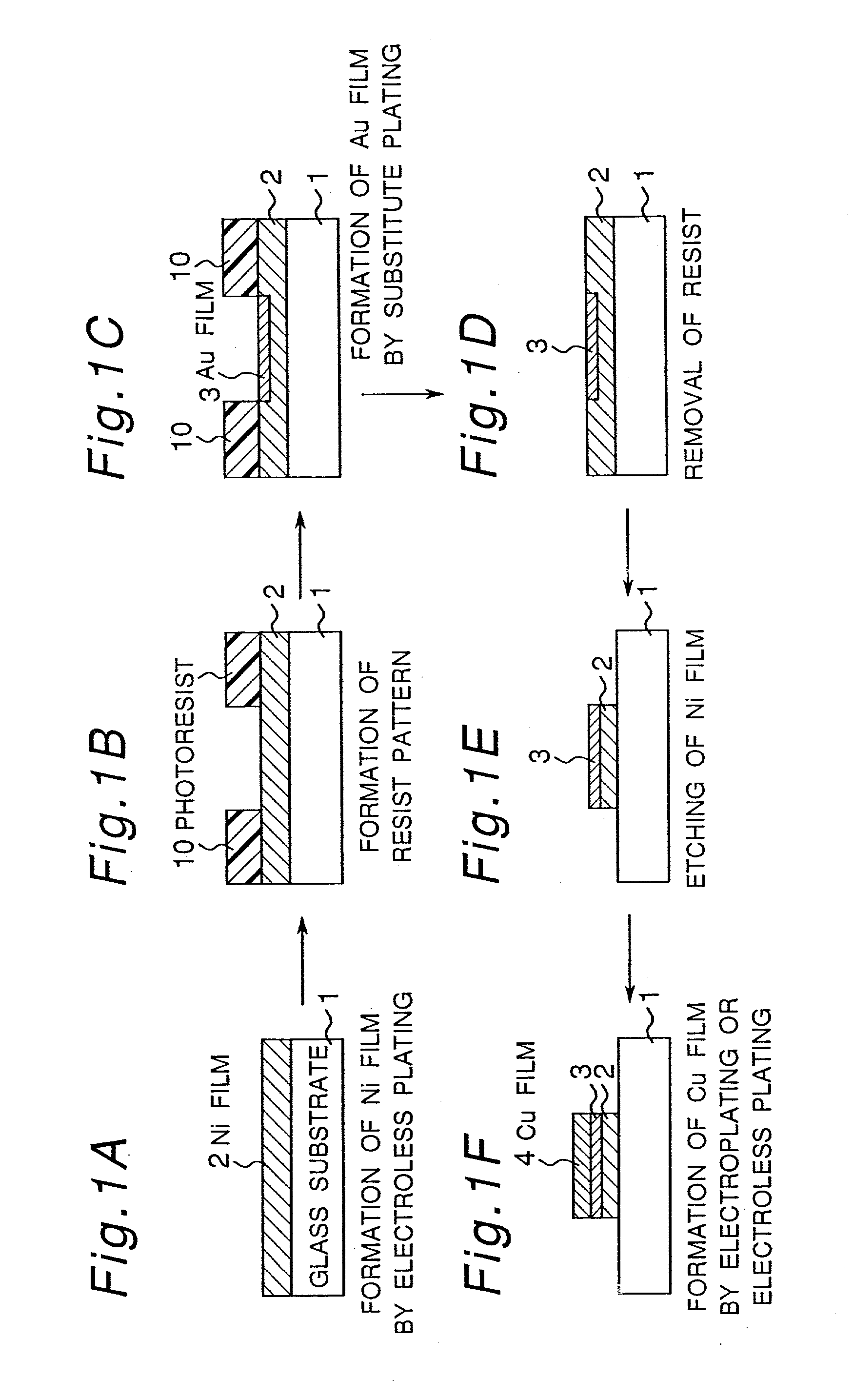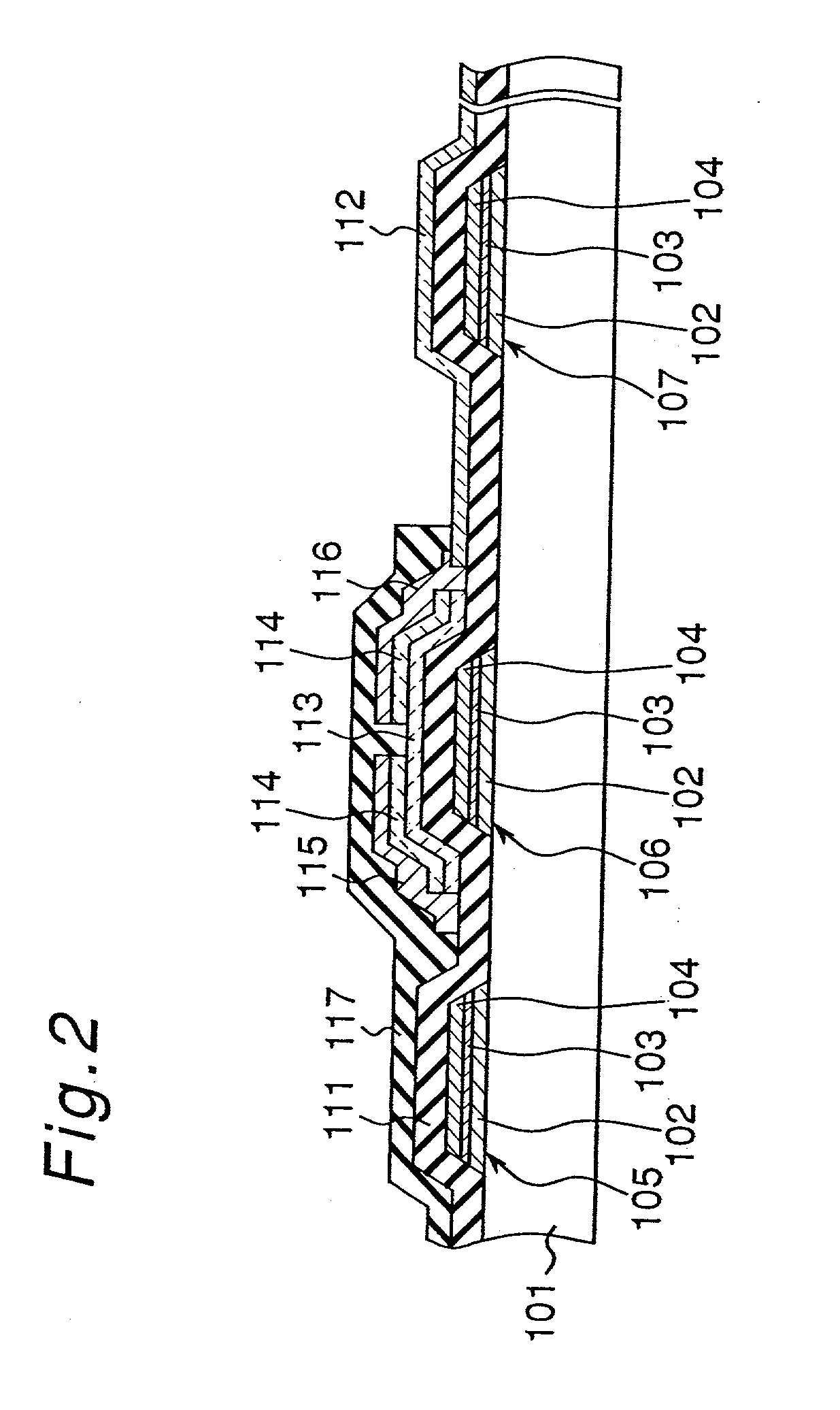Method for fabricating metal interconnections
a metal interconnection and metal technology, applied in the direction of identification means, instruments, semiconductor devices, etc., can solve the problems of large delay of driving signals, process increase, cost increase, etc., and achieve low resistance interconnection, low resistance, and low price
- Summary
- Abstract
- Description
- Claims
- Application Information
AI Technical Summary
Benefits of technology
Problems solved by technology
Method used
Image
Examples
embodiment 1
[0043] (Embodiment 1)
[0044] Embodiment 1 of the invention is constituted of first to sixth steps shown FIGS. 1A-1F, respectively.
[0045] At the first step shown in FIG. 1A, on a glass substrate 1 as an insulating substrate, is formed a nickel (Ni) film 2 as a ground metal film superior in adhesion to glass by electroless plating.
[0046] More specifically, at this first step, the glass substrate (e.g., #1737 made by Corning Inc.) 1 having a thickness of, for example, 0.7 mm is degreased and cleaned by alkali or acid or organic solvent so that dirties of surfaces of the glass substrate 1 are removed. In this process, by using ultrasonic cleaning in combination, dirties are removed efficiently. Next, the glass substrate 1 is dipped into the aqueous solution containing amino compounds, by which coating of amino compounds is formed on the surface of the glass substrate 1. This coating of amino compounds is extremely high in adhesion to the glass substrate 1 and has amino groups, so that pa...
embodiment 2
[0083] (Embodiment 2)
[0084] Embodiment 2 is another fabrication method for obtaining interconnections of the same structure as the metal interconnections described in Embodiment 1.
[0085] FIGS. 3A-3F show first to sixth steps of Embodiment 2, respectively. The first to third steps of Embodiment 2 shown in FIGS. 3A-3C are the same as the first to third steps of Embodiment 1 shown FIGS. 1A-1C, respectively.
[0086] In detail, at the first step shown in FIG. 3A, on a glass substrate 11 which is an insulating substrate, is formed a nickel film 12 as a ground metal film superior in adhesion to glass by electroless plating. At the second step shown in FIG. 3B, a photoresist film 20 is formed on the Ni film 12 in correspondence to interconnecting portions. Then, at the third step shown in FIG. 3C, a Au film 13 which is a noble metal film is formed by electroless plating at an opening portion of the photoresist film 20, i.e., on the exposed Ni film 12. As in Embodiment 1, the thickness of the ...
embodiment 3
[0094] (Embodiment 3)
[0095] Embodiment 3 is another method for obtaining interconnections of the same structure as the metal interconnections described in Embodiment 1.
[0096] FIGS. 5A-5F show first to sixth steps of Embodiment 2, respectively.
[0097] In detail, at the first step shown in FIG. 5A, on a glass substrate 31 which is an insulating substrate, is formed a nickel film 32 as a ground metal film superior in adhesion to glass by electroless plating. The method of electroless Ni-plating, the thickness of the Ni film and the like are the same as in foregoing Embodiment 1. At the second step shown in FIG. 5B, a photoresist film 30 is formed on the Ni film 32 in correspondence to interconnecting portions. The method of forming the photoresist film 30 is the same as in foregoing Embodiment 1. However, in this embodiment, a patterned photoresist film 30 is formed in a region corresponding to the interconnecting portion. Then, at the third step shown in FIG. 5C, an opening portion of ...
PUM
 Login to View More
Login to View More Abstract
Description
Claims
Application Information
 Login to View More
Login to View More - R&D
- Intellectual Property
- Life Sciences
- Materials
- Tech Scout
- Unparalleled Data Quality
- Higher Quality Content
- 60% Fewer Hallucinations
Browse by: Latest US Patents, China's latest patents, Technical Efficacy Thesaurus, Application Domain, Technology Topic, Popular Technical Reports.
© 2025 PatSnap. All rights reserved.Legal|Privacy policy|Modern Slavery Act Transparency Statement|Sitemap|About US| Contact US: help@patsnap.com



